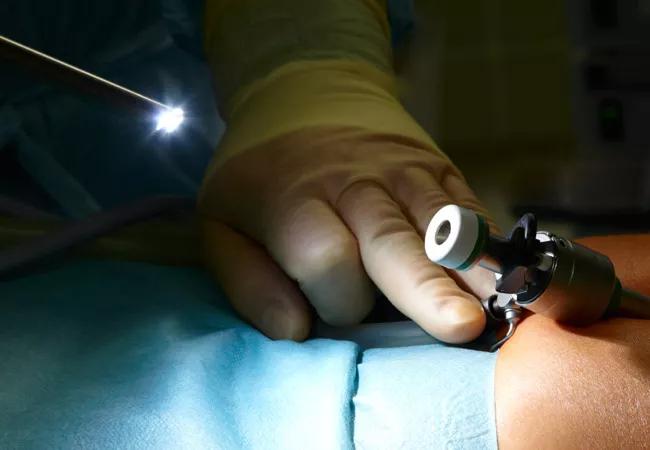Statistically significant, clinically relevant findings

The refinement of minimally invasive, laparoscopic and robotic technologies as replacements for open surgery continues to forge ahead, yet the research needed to anchor these surgical choices in strong evidence often lags behind. At Cleveland Clinic’s Digestive Disease & Surgery Institute, Ajita Prabhu, MD, who specializes in minimally invasive surgery, works to close the gap by aggressively contributing to the body of published research on robotic hernia repair.
Advertisement
Cleveland Clinic is a non-profit academic medical center. Advertising on our site helps support our mission. We do not endorse non-Cleveland Clinic products or services. Policy
Dr. Prabhu was an investigator in the first comparative study, published in the March 2017 Annals of Surgery, looking at robotic retromuscular ventral hernia repair (r-RVHR) vs. open retromuscular ventral hernia repair (o-RVHR). Using propensity scoring, 111 r-RVHR procedures were matched to 222 o-RVHR procedures, performed by 39 surgeons. Dr. Prabhu was one of the surgeons contributing open and robotic case information, which was then aggregated by the American Hernia Society Quality Collaborative (AHSQC).
“In my own experience, r-RVHR has led to lower hospital LOS. Through the study, I saw this borne out in the experience of the other surgeons as well.” The authors concluded that “the robotic-assisted approach resulted in a postoperative LOS reduction (two vs. three days), which was both “statistically significant and clinically relevant.”
The reasons may be multifactorial, including smaller incision size, decreased retractor use (so less stress on the tissues), and the application of the less traumatic retromuscular suture mesh fixation technique vs. transfascial suture mesh fixation. The clinically relevant benefit appears to be reduced postoperative pain, which heavily influences an earlier discharge decision. “When patients experience less pain, they are up sooner, have lower risk for complications and more quickly return to life activities and work,” Dr. Prabhu says.
Numerous other factors were measured in the study, but do not significantly support the use of one procedure over the other. Surgical site occurrence (SSO) was higher in r-RVHR, but this was largely due to seromas that resolved without intervention. In fact, surgical site occurrence requiring procedural intervention (SSOPI) was nearly the same for r-RVHR (4 percent) vs. o-RHVR (5 percent). Readmission rates were low, with differences between the groups negligible. Similarly, rates of UTI, pneumonia, bleeding and death were low and displayed no statistically significant differences between the groups.
Advertisement
Given that a full inpatient day is saved, and that its average cost in the U.S. is about $2,271 (2015, American Hospital Association), if all else were equal, r-RVHR might be standard protocol for this surgery. But many other costs of r-RVHR have to be considered, including the robotic equipment purchase itself, docking time, instruments and draping, the specialized training and learning curve for surgeons, as well as longer operating room occupancy.
Pinning some of these costs down, however, is like trying to hit a moving target, Dr. Prabhu says. For example, training expenses are front-heavy, attenuating over time. The length of OR occupancy may or may not be a cost issue, varying with surgeons’ skills and experience with robotics, and even the scheduling requirements for each facility. These and other factors make each healthcare institution’s cost/benefit analysis challenging.
One variable cost associated with a mesh implant is the prosthetic itself. An uncoated mesh costs hundreds of dollars versus the several thousand that a coated, nonadhesive mesh costs. While some procedures such as the laparoscopic implants require the coated mesh, the AHSQC study shows that uncoated meshes can be effectively utilized in rRVHR, as in oRVHR. This helps equalize the expense of the r-RVHR and o-RVHR procedures.
Does Dr. Prabhu endorse robotics in every case? “The robotic procedure is not right for everyone. Some patients, particularly those who have had multiple previous hernia repairs, with mesh already in their abdomens, are best served by open procedures,” she explains. Strong candidates for r-RVHR include patients who have relatively large ventral hernia defects but a minimal number of prior surgeries, who don’t need revision of the skin or subcutaneous tissue on the abdominal wall and who are at low risk for multiple abdominal adhesions.
Advertisement
She urges further research, retrospective and prospective, to further define best candidates and shine a clearer light on the true benefits and costs. So far, however, r-RVHR is proving it is worth this pursuit. Dr. Prabhu states it simply: “My philosophy is that if you can perform the exact same technique with a minimally invasive approach that is a win for everyone. Looking at this finding, this is clearly the case.”
Advertisement
Advertisement

Study reveals key differences between antibiotics, but treatment decisions should still consider patient factors

Key points highlight the critical role of surveillance, as well as opportunities for further advancement in genetic counseling

Potentially cost-effective addition to standard GERD management in post-transplant patients

Findings could help clinicians make more informed decisions about medication recommendations

Retrospective analysis looks at data from more than 5000 patients across 40 years

Surgical intervention linked to increased lifespan and reduced complications

Diagnostic and management pearls for an emerging condition linking tick-bites to meat allergy

Insights into an emerging condition linking tick bites to meat sensitization